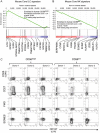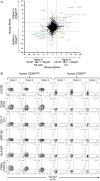Transcriptome analysis reveals similarities between human blood CD3- CD56bright cells and mouse CD127+ innate lymphoid cells
- PMID: 28615725
- PMCID: PMC5471261
- DOI: 10.1038/s41598-017-03256-0
Transcriptome analysis reveals similarities between human blood CD3- CD56bright cells and mouse CD127+ innate lymphoid cells
Abstract
For many years, human peripheral blood natural killer (NK) cells have been divided into functionally distinct CD3- CD56bright CD16- and CD3- CD56dim CD16+ subsets. Recently, several groups of innate lymphoid cells (ILC), distinct from NK cells in development and function, have been defined in mouse. A signature of genes present in mouse ILC except NK cells, defined by Immunological Genome Project studies, is significantly over-represented in human CD56bright cells, by gene set enrichment analysis. Conversely, the signature genes of mouse NK cells are enriched in human CD56dim cells. Correlations are based upon large differences in expression of a few key genes. CD56bright cells show preferential expression of ILC-associated IL7R (CD127), TNFSF10 (TRAIL), KIT (CD117), IL2RA (CD25), CD27, CXCR3, DPP4 (CD26), GPR183, and MHC class II transcripts and proteins. This could indicate an ontological relationship between human CD56bright cells and mouse CD127+ ILC, or conserved networks of transcriptional regulation. In line with the latter hypothesis, among transcription factors known to impact ILC or NK cell development, GATA3, TCF7 (TCF-1), AHR, SOX4, RUNX2, and ZEB1 transcript levels are higher in CD56bright cells, while IKZF3 (AIOLOS), TBX21 (T-bet), NFIL3 (E4BP4), ZEB2, PRDM1 (BLIMP1), and RORA mRNA levels are higher in CD56dim cells.
Conflict of interest statement
The authors declare that they have no competing interests.
Figures




References
-
- Lanier LL, Le AM, Civin CI, Loken MR, Phillips JH. The relationship of CD16 (Leu-11) and Leu-19 (NKH-1) antigen expression on human peripheral blood NK cells and cytotoxic T lymphocytes. J Immunol. 1986;136:4480–4486. - PubMed
Publication types
MeSH terms
Substances
Grants and funding
LinkOut - more resources
Full Text Sources
Other Literature Sources
Research Materials
Miscellaneous

